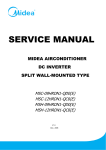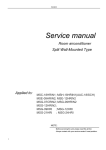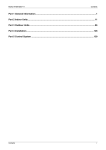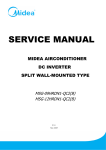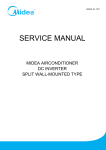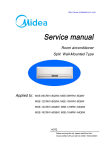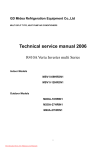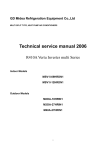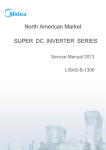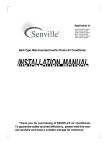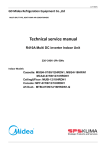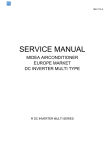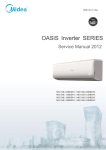Download MSV1-09HRDN1 MSV1-12HRDN1
Transcript
Cover MSV1-09HRDN1 MSV1-12HRDN1 Content Content 1. Precaution .......................................................................................................................... 1 1.1 1.2 2. 3. Safety Precaution .............................................................................................................................. 1 Warning ............................................................................................................................................. 1 Function.............................................................................................................................. 3 Dimension........................................................................................................................... 5 3.1 3.2 4. 5. 6. Indoor unit(Vertu) .......................................................................................................................... 5 Outdoor unit(Vertu) ....................................................................................................................... 5 Specification....................................................................................................................... 6 Refrigerant cycle diagram ................................................................................................. 7 Operation limits.................................................................................................................. 8 6.1 6.2 7. Cooling operation............................................................................................................................... 8 Heating operation .............................................................................................................................. 8 Schematic diagram and Wiring diagram.......................................................................... 9 7.1. 7.2. 8. Schematic diagram ............................................................................................................................ 9 Wiring diagram ................................................................................................................................ 13 Installation details ............................................................................................................ 14 8.1 8.2 8.3 8.4 8.5 8.6 8.7 8.8 8.9 9. Wrench torque sheet for installation ................................................................................................ 14 Connecting the cables ..................................................................................................................... 14 Pipe length and the elevation .......................................................................................................... 14 Air purging of the piping and indoor unit .......................................................................................... 15 Pumping down (Re-installation) ....................................................................................................... 16 Re-air purging (Re-installation) ........................................................................................................ 17 Balance refrigerant of the 2-way, 3-way valves................................................................................ 18 Evacuation....................................................................................................................................... 19 Gas charging ................................................................................................................................... 20 Pressure table .................................................................................................................. 21 9.1 9.2 10. MSV1-09HRDN1 ............................................................................................................................. 21 MSV1-12HRDN1 ............................................................................................................................. 21 Capacity table................................................................................................................... 22 10.1 10.2 11. MSV1-09HRDN1 ............................................................................................................................. 22 MSV1-12HRDN1 ............................................................................................................................. 22 Electronic function........................................................................................................... 24 11.1. 11.2. 11.3. 11.4. 11.5. 11.6. 11.7. 11.8. 11.9. 2 Display board................................................................................................................................... 24 Protection ........................................................................................................................................ 25 Fan-only mode................................................................................................................................. 25 Cooling mode .................................................................................................................................. 25 Dehumidifying mode ........................................................................................................................ 26 Heating mode .................................................................................................................................. 26 Defrosting operation (Available for heating only). ............................................................................ 27 Outdoor low temperature protection (optional) ................................................................................ 28 Automatic operation mode............................................................................................................... 28 Content 11.10. 11.11. 11.12. 11.13. 11.14. 12. 13. 13.1 13.2 13.3 13.4 13.5 13.6 13.7 13.8 14 3 Manual switch .................................................................................................................................. 28 Timer Function................................................................................................................................. 28 Sleep mode ..................................................................................................................................... 28 Auto restart function......................................................................................................................... 29 Turbo function.................................................................................................................................. 29 Model and Parameters..................................................................................................... 30 Troubleshooting ............................................................................................................... 31 Indoor Unit Error Display ................................................................................................................. 31 Diagnostic chart ............................................................................................................................... 36 Resetting phenomenon often occurs during operation .................................................................... 38 Operation lamp flashes and Timer lamp off ..................................................................................... 38 Operation lamp flashes and Timer lamp on ..................................................................................... 38 Operation lamp off and Timer lamp flashes ..................................................................................... 39 Operation lamp on and Timer lamp flashes ..................................................................................... 39 Operation lamp flashes, Timer lamp flashes.................................................................................... 39 Characteristic of temperature sensor ............................................................................ 40 Service manual 1. 1.1 Precaution Safety Precaution To prevent injury to the user or other people and property damage, the following instructions must be followed. Incorrect operation due to ignoring instruction will cause harm or damage. Before service unit, be sure to read this service manual at first. 1.2 Warning Installation Do not use a defective or underrated circuit breaker. Use this appliance on a dedicated circuit. There is risk of fire or electric shock. For electrical work, contact the dealer, seller, a qualified electrician, or an Authorized service center. Do not disassemble or repair the product, there is risk of fire or electric shock. Always ground the product. There is risk of fire or electric shock. Install the panel and the cover of control box securely. There is risk of fire of electric shock. Always install a dedicated circuit and breaker. Improper wiring or installation may cause fore or electric shock. Use the correctly rated breaker of fuse. There is risk of fire or electric shock. Do not modify or extend the power cable. There is risk of fire or electric shock. Do not install, remove, or reinstall the unit by yourself (customer). There is risk of fire, electric shock, explosion, or injury. Be caution when unpacking and installing the product. Sharp edges could cause injury, be especially careful of the case edges and the fins on the condenser and evaporator. For installation, always contact the dealer or an Authorized service center. There is risk of fire, electric shock, explosion, or injury. Do not install the product on a defective installation stand. It may cause injury, accident, or damage to the product. Be sure the installation area does not deteriorate with age. If the base collapses, the air conditioner could fall with it, causing property damage, product failure, and personal injury. Do not let the air conditioner run for a long time when the humidity is very high and a door or a windows is left open. Moisture may condense and wet or damage furniture. Take care to ensure that power cable could not be pulled out or damaged during operation. There is risk of fire or electric shock. Do not place anything on the power cable. 1 There is risk of fire or electric shock. Do not plug or unplug the power supply plug during operation. There is risk of fire or electric shock. Do not touch (operation) the product with wet hands. There is risk of fire or electric shock. Do not place a heater or other appliance near the power cable. There is risk of fire and electric shock. Do not allow water to run into electric parts. It may cause fire, failure of the product, or electric shock. Do not store or use flammable gas or combustible near the product. There is risk of fire or failure of product. Do not use the product in a tightly closed space for a long time. Oxygen deficiency could occur. When flammable gas leaks, turn off the gas and open a window for ventilation before turn the product on. Do not use the telephone or turn switches on or off. There is risk of explosion or fire. If strange sounds, or small or smoke comes from product. Turn the breaker off or disconnect the power supply cable. There is risk of electric shock or fire. Stop operation and close the window in storm or hurricane. If possible, remove the product from the window before the hurricane arrives. There is risk of property damage, failure of product, or electric shock. Do not open the inlet grill of the product during operation. (Do not touch the electrostatic filter, if the unit is so equipped.) There is risk of physical injury, electric shock, or product failure. When the product is soaked (flooded or submerged), contact an Authorized service center. There is risk of fire or electric shock. Be caution that water could not enter the product. There is risk of fire, electric shock, or product damage. Ventilate the product from time to time when operating it together with a stove, etc. There is risk of fire or electric shock. Turn the main power off when cleaning or maintaining the product. Service manual There is risk of electric shock. When the product is not be used for a long time, disconnect the power supply plug or turn off the breaker. There is risk of product damage or failure, or unintended operation. Take care to ensure that nobody could step on or fall onto the outdoor unit. This could result in personal injury and product damage. CAUTION Always check for gas (refrigerant) leakage after installation or repair of product. Low refrigerant levels may cause failure of product. Install the drain hose to ensure that water is drained away properly. A bad connection may cause water leakage. Keep level even when installing the product. To avoid vibration of water leakage. Do not install the product where the noise or hot air from the outdoor unit could damage the neighborhoods. It may cause a problem for your neighbors. Use two or more people to lift and transport the product. Avoid personal injury. Do not install the product where it will be exposed to sea wind (salt spray) directly. It may cause corrosion on the product. Corrosion, particularly on the condenser and evaporator fins, could cause product malfunction or inefficient operation. Operational Do not expose the skin directly to cool air for long periods of time. (Do not sit in the draft). This could harm to your health. Do not use the product for special purposes, such as preserving foods, works of art, etc. It is a 2 consumer air conditioner, not a precision refrigerant system. There is risk of damage or loss of property. Do not block the inlet or outlet of air flow. It may cause product failure. Use a soft cloth to clean. Do not use harsh detergents, solvents, etc. There is risk of fire, electric shock, or damage to the plastic parts of the product. Do not touch the metal parts of the product when removing the air filter. They are very sharp. There is risk of personal injury. Do not step on pr put anything on the product. (outdoor units) There is risk of personal injury and failure of product. Always insert the filter securely. Clean the filter every two weeks or more often if necessary. A dirty filter reduces the efficiency of the air conditioner and could cause product malfunction or damage. Do not insert hands or other object through air inlet or outlet while the product is operated. There are sharp and moving parts that could cause personal injury. Do not drink the water drained from the product. It is not sanitary could cause serious health issues. Use a firm stool or ladder when cleaning or maintaining the product. Be careful and avoid personal injury. Replace the all batteries in the remote control with new ones of the same type. Do not mix old and mew batteries or different types of batteries. There is risk of fire or explosion. Do not recharge or disassemble the batteries. Do not dispose of batteries in a fire. They may burn of explode. If the liquid from the batteries gets onto your skin or clothes, wash it well with clean water. Do not use the remote of the batteries have leaked. The chemical in batteries could cause burns or other health hazards. Service manual 2. Function Indoor unit Operation ON/OFF by remote controller Sensing by room temperature Room temperature sensor. Pipe temperature sensor. Room temperature control Maintain the room temperature in accordance with the setting temperature. Anti-freezing control in cooling Prevent the water being freezed on evaporator by sensing the evaporator pipe temperature in cooling mode Work voltage (160v-253v) High efficiency (30%) Time Delay Safety control Restarting is for approx. 3 minutes.. Indoor fan speed control Tele Remote control (Optional) Self-diag. function Turbo wind, high, med, low, breeze. Anti-cold function Two-direction air vane The unit will decide the louver direction according to operation mode. Sleep mode auto control The fan is turn to low speed (cooling/heating). The unit will be turn off at the seventh hour. Independent dehumidification The function is usually used in rainy days in springtime or damp areas. Air flow Direction control The louver can be set at the desired position or swing up and down automatically Auto mode The mode can be change by the room temperature. Prevent the cold wind at the beginning of unit start. Plasma (Optional) The function will be operated in any operation mode. Auto defrost Auto-restart function When the power supply is interrupted and then restore, the air conditioners automatically restore the previous function setting. Flexible wiring connection DSP High-speed Chip Temp. Compensation Driving heating at -15℃ 3 Service manual Outdoor unit Power relay control The unit has 3 mins delay between continuously ON/OFF operations. Low noise air flow system Bird tail propeller fan makes the outdoor unit run more quietly. Hydrophilic aluminum fin The hydrophilic fin can improve the heating efficiency at operation mode. 4 way valve control It is only operated in the heating operation mode except defrosting operation. Anti-rust cabinet Made from electrolytic zinc steel sheet and anti-rust coated components. Valve protection cover It protects the valves and prevents water from dripping. Discharge pipe temperature protect 4 Service manual 3. 3.1 Dimension Indoor unit(Vertu) Dimension Mode W H D 9K 795 270 165 12K 845 286 165 3.2 5 Outdoor unit(Vertu) Dimension Mode W H D 9K 760 590 285 12K 760 590 285 Service manual 4. Specification Model Power supply Cooling Heating Capacity Input Rated current EER Capacity Input Rated current COP Moisture Removal Max. input consumption Max. current Starting current Model Type Brand Capacity Input Compressor Rated current(RLA) Locked rotor Amp(LRA) Thermal protector Capacitor Refrigerant oil Model Brand Indoor fan motor Input Capacitor Speed(hi/mi/lo) Indoor air flow (Hi/Mi/Lo) Indoor noise level (Hi/Mi/Lo) Model Brand Outdoor fan motor Input Capacitor Speed Outdoor air flow Outdoor noise level Refrigerant type R410A Design pressure Liquid side/ Gas side Refrigerant piping Max. refrigerant pipe leng Max. difference in level Operation temp Ambient temp Application area Ph-V-Hz Btu/h W A Btu/w.h, w/w Btu/h W A W/W L/h W A A Btu/h W A A uF ml W uF r/min m3/h dB(A) W uF r/min m3/h dB(A) g MPa mm(inch) m m ℃ ℃ m2 MSV1-09HRDN1 1,220-240V~,50Hz 9000(3500-11000) 810(260-1350) 3.3(1.5-7.0) 11.1,3.26 10000(3500-13800) 810(330-1550) 3.5(1.4-7.5) 3.62 0.86 1900 10 3.3 DA89X1C-23FZ Rotary TOSHIBA 9040 680 4.7 10 CS-74 No 370 RPG20D Welling 51.5 1.5 1150/1000/850 570/480/350 40/34/29 YDK24-6F Welling 56 2.5 800 1700 53 980 4.2 Ф6.35/Ф9.53 12 5 17 - 30 -15 -50 14-21 MSV1-12HRDN1 1, 220-240V~, 50Hz 12000(4400-14500) 1090(520-1600) 5.1(2.7~8.5) 11.0, 3.21 14000(4800-20500) 1130(520-2050) 5.2(2.7-10.0) 3.63 1.2 2550 12 4.1 DA89X1C-23FZ Rotary TOSHIBA 9040 680 4.7 10 CS-74 No 370 RPG20D Welling 51.5 1.5 1250/1050/900 700/520/420 42/35/29 YDK24-6F Welling 56 2.5 800 1900 56 1150 4.2 Ф6.35/Ф12.7 12 5 17 -30 -15 -50 18-26 Note: The noise date is base on hemi-anechoic chamber, during actual operation; these values are normally somewhat different as a result of ambient condition. The above design and specifications are subject to change without prior notice for product improvement. 6 Service manual 5. 7 Refrigerant cycle diagram Service manual 6. 6.1 Operation limits Cooling operation Outdoor unit air temp.℃ DB Indoor air temp. ℃ DB Note: The chart is the result from the continuous operation under constant air temperature conditions. However, excludes the initial pull-down stage. 6.2 Heating operation Indoor air temp. ℃ DB Outdoor unit air temp.℃ DB Note: The chart is the result from the continuous operation under constant air temperature conditions. However, excludes the initial pull-down stage. 8 Service manual 7. 7.1. Schematic diagram and Wiring diagram Schematic diagram 7.1.1 Display board 9 Service manual 7.1..2 Indoor main PCB 10 Service manual 7.1.3 Outdoor main PCB 11 Service manual 7.1.4 Outdoor power PCB 12 Service manual 7.2. Wiring diagram 7.2.1 MSV1-09HRDN1, MSV1-12HRDN1 13 Service manual 8. 8.1 8.2 Installation details Wrench torque sheet for installation Outside diameter Torque mm inch Kg.m φ6.35 1/4 1.8 φ9.52 3/8 4.2 φ12.7 1/2 5.5 φ15.88 5/8 6.6 φ19.05 3/4 6.6 Connecting the cables The power cord of connect should be selected according to the following specifications sheet. Grade Unit mm 8.3 Capacity Btu/h 7k~12K 18K~28K 2 7K 9K 12K 1.0 1.0 1.5 Pipe length and the elevation Pipe size Standard length (m) Max. Elevation B (m) Max. Elevation B (m) Additional refrigerant (g/m) GAS LIQUID 3/8’’ (φ9.52) 1/4’’ (φ6.35) 5 5 10 30 1/2’’ (φ12.7) 1/4’’ (φ6.35) 5 5 10 30 1/2’’ (φ12.7) 1/4’’ (φ6.35) 5 8 15 30 5/8’’ (φ15.88) 1/4’’ (φ6.35) 5 10 20 30 5/8’’ (φ15.88) 3/8’’ (φ9.52) 5 10 20 65 In case that more than 5m. Caution: Capacity is base on standard length and maximum allowance length is base of reliability. Oil trap should be install per 5-7 meters. 14 Service manual 8.4 Air purging of the piping and indoor unit Required tools: Hexagonal wrench; adjustable wrench; torque wrenches, wrench to hold the joints and gas leak detector. Note: The air in the indoor unit and in the piping must be purged. If air remains in the refrigeration piping, it will affect the compressor, reduce the cooling capacity, and could lead to a malfunction of unit. Be sure, using a torque wrench to tighten the service port cap (after using the service port), so that it prevents the gas leakage from the refrigeration cycle. Procedure 1. Recheck the piping connections. 2. Open the valve stem of the 2-way valve counterclockwise approximately 90’, wait 10 seconds, and then set it to closed position. Be sure to use a hexagonal wrench to operate the valve stem 3. Check for gas leakage. Check the flare connection for gas leakage 4. Purge the air from the system. Set the 2-way valve to the open position and remove the cap from the 3-way valve’s service port. Using the hexagonal wrench to press the valve core pin, discharge for three seconds and then wait for one minute. 5. Use torque wrench to tighten the service port cap to a torque of 1.8 kg.m. (18n.m) 15 6. Set the 3-way valve to the opened position. 7. Mounted the valve stem nuts to the 2-way and 3-way valves. 8. Check for gas leakage. At this time, especially check for gas leakage from the 2-way and 3-way stem nuts, and from the service port. Caution: If gas leakage is discovered in step (3) above, take the following measures. If the leaks stop when the piping connections are tightened further, continue working from step (4). If the gas leaks do not stop when the connections are retightened, repair the location of the leak, discharge all of the gas through the service port, and then recharge with the specified amount of gas from a gas cylinder. Service manual 8.5 Pumping down (Re-installation) Procedure 1. Confirm that both the 2-way and 3-way valves are set to the opened position. Remove the valve stem caps and confirm that the valve stems are in the opened position. Be sure to use a hexagonal wrench to operate the valve stems. 2. Operate the unit for 10 to 15 minutes. 3. Stop operation and wait for 3 minutes, then connect the charge set to the service port of the 3-way valve. Connect the charge hose with the push pin to the gas service port. 4. Air purging of the charge hose. Open the low-pressure valve on the charge set slightly to purge air from the charge hose. 5. Set the 2-way valve to the close position. 6. Operate the air conditioner at the cooling cycle and stop it when the gauge indicates 0.1MPa. 7. Immediately set the 3-way valve to the closed position. Do this quickly so that the gauge ends up indicating 0.3 to 0.5Mpa. 8. Disconnect the charge set, and amount the 2-way and 3-way valve’s stem nuts and service port caps. Use a torque wrench to tighten the service port cap to a torque of 1.8 kg.m. Be sure to check for gas leakage. 16 Service manual 8.6 Re-air purging (Re-installation) Procedure: 1. Confirm that both the 2-way and 3-way valves are set to the closed position. 2. Connect the charge set and a charging cylinder to the service port of the 3-way valve. Leave the valve on the charging cylinder closed. 3. Air purging. Open the valves on the charging cylinder and the charge set. Purge the air by loosening the flare nut on the 2-way valve approximately 45’ for 3 seconds then closing it for 1 minutes; repeat 3 times. After purging the air, use a torque wrench to tighten the flare nut to on the 2-way valve. 4. Check the gas leakage. Check the flare connections for gas leakage. 5. Discharge the refrigerant. Close the valve on the charging cylinder and discharge the refrigerant until the gauge indicate 0.3 to 0.5 Mpa. 6. Disconnect the charge set and the charging cylinder, and set the 2-way and 3-way valves to the open position. Be sure to use a hexagonal wrench to operate the valve stems. 7. Mount the valve stems nuts and the service port cap. Be sure to use a torque wrench to tighten the service port cap to a torque 18N.m. Be sure to check the gas leakage. 17 Service manual 8.7 Balance refrigerant of the 2-way, 3-way valves Procedure: 1. Confirm that both the 2-way and 3-way valves are set to the open position. 2. Connect the charge set to the 3-way valve’s service port. Leave the valve on the charge set closed. Connect the charge hose with the push pin to the service port. 3. Open the valves (Low side) on the charge set and discharge the refrigerant until the gauge indicates 0.05 to 0.1 Mpa. If there is no air in the refrigeration cycle [the pressure when the air conditioner is not running is higher than 0.1Mpa, discharge the refrigerant until the gauge indicates 0.05 to 0.1 Mpa. If this is the case, it will not be necessary to apply a evacuation. Discharge the refrigeration gradually; if it is discharged too suddenly, the refrigeration oil sill be discharged. 18 Service manual 8.8 Evacuation Procedure: 1. Connect the vacuum pump to the charge set’s centre hose. 2. Evacuation for approximately one hour. Confirm that the gauge needle has moved toward -0.1 Mpa (-76 cmHg) [vacuum of 4 mmHg or less]. 3. Close the valve (Low side) on the charge set, turn off the vacuum pump, and confirm that the gauge needle does not move (approximately 5 minutes after turning off the vacuum pump). 4. Disconnect the charge hose from the vacuum pump. Vacuum pump oil, if the vacuum pump oil becomes dirty or depleted, replenish as needle. 19 Service manual 8.9 Gas charging Procedure: 1. Connect the charge hose to the charging cylinder. Connect the charge hose which you disconnected from the vacuum pump to the valve at the bottom of the cylinder. 2. Purge the air from the charge hose. Open the valve at the bottom of the cylinder and press the check valve on the charge set to purge the air (be careful of the liquid refrigerant). 3. Open the valves (Low side) on the charge set and charge the system with liquid refrigerant. If the system cannot be charge with the specified amount of refrigerant, if can be charged with a little at a time (approximately 150g each time0 while operating the air conditioner in the cooling cycle; however, one time is not sufficient, wait approximately 1 minute and then repeat the procedure.(pumping down-pin). 4. Immediately disconnect the charge hose from the 3-way valve’s service port. Stopping partway will allow the refrigerant to be discharged. If the system has been charged with liquid refrigerant while operating the air conditioner, turn off the air conditioner before disconnecting the hose. 5. Mounted the valve stem caps and the service port Use torque wrench to tighten the service port cap to a torque of 18N.m. Be sure to check for gas leakage. 20 Service manual 9. Pressure table Note: The pressure data is from 3 way valve, the pressure data are pressure above atmosphere. D: Dry bulb temp. W: Wet bulb temp. 9.1 MSV1-09HRDN1 Cooling mode Outdoor temperature (Dry bulb temp) Indoor Conditions Pressure 25ºC 30ºC 35ºC 40ºC 45ºC 50ºC 2 21ºC D15ºC W Pressure( kg/cm ) 8.7 8.9 8.9 9.0 10.0 10.6 24ºC D17ºC W Pressure( kg/cm2 ) 8.8 8.9 8.9 9.6 10.5 11.0 27ºC D19ºC W Pressure( kg/cm2 ) 8.8 8.9 9.0 9.0 32ºC D23ºC W Pressure( kg/cm2 ) 8.9 9.0 9.1 10.1 12.0 12.5 Heating mode OUTDOOR CONDITIONS Indoor Conditions 12ºC D 7ºC D 0ºC D -4ºC D -7ºC D -15ºC D Pressure 11ºC W 6ºC W -1ºC W -6ºC W -9ºC W -xºC W Pressure( kg/cm2 ) 34.0 15ºC 18ºC 11.0 11.5 33.5 32.0 31.0 28.0 27.0 2 34.5 34.0 32.5 29.0 27.5 2 Pressure( kg/cm ) 35.0 20ºC Pressure( kg/cm ) 36.5 36.0 35.5 33.5 30.0 28.5 22ºC Pressure( kg/cm2 ) 37.0 36.5 36.0 35.0 31.5 29.0 9.2 MSV1-12HRDN1 Outdoor temperature (Dry bulb temp) Cooling mode Indoor Conditions 21ºC D15ºC W Pressure 25ºC 30ºC 35ºC 40ºC 45ºC 50ºC 2 6.4 6.6 6.8 7.2 7.6 8.1 2 Pressure( kg/cm ) 24ºC D17ºC W Pressure( kg/cm ) 6.6 6.9 7.0 7.6 8.2 8.7 27ºC D19ºC W Pressure( kg/cm2 ) 6.9 7.0 7.3 7.6 8.6 9.2 32ºC D23ºC W Pressure( kg/cm2 ) 6.9 7.4 7.6 8.1 9.4 9.8 Heating mode Indoor Conditions 15ºC 18ºC 20ºC 22ºC 21 OUTDOOR CONDITIONS 12ºC D 7ºC D 0ºC D -4ºC D -7ºC D -15ºC D Pressure 2 36.0 35..0 34.5 30.0 29.0 28.0 2 33.0 34.0 33.5 30.0 28.5 27.5 2 34.0 33.0 31.0 30.5 29.0 26.0 2 32.5 31.5 31.0 29.0 28.0 25.5 Pressure( kg/cm ) Pressure( kg/cm ) Pressure( kg/cm ) Pressure( kg/cm ) Service manual 10. Capacity table 10.1 MSV1-09HRDN1 COOLING OUTDOOR TEMPERATURE DRY Indoor Conditions 21ºC D 15ºC W 24ºC D 17ºC W 27ºC D 19ºC W 32ºC D 23ºC W Total capacity kW Sensitive capacity kW Input kW. Total capacity kW Sensitive capacity kW Input kW. Total capacity kW Sensitive capacity kW Input kW. Total capacity kW Sensitive capacity kW Input kW. 21ºC 25ºC 30ºC 35ºC 40ºC 45ºC 50ºC 2.87 1.84 0.701 2.98 1.84 0.72 3.13 2.04 0.75 3.29 2.17 0.78 3.00 1.91 0.72 3.15 2.01 0.73 3.20 2.15 0.78 3.33 2.15 0.80 2.60 2.03 0.80 2.85 2.23 0.82 2.98 2.30 0.85 3.12 2.43 0.86 2.34 1.99 0.86 2.45 2.11 0.90 2.58 1.96 0.76 3.05 2.56 1.00 1.98 1.65 0.89 2.30 1.93 0.92 2.60 2.23 0.96 2.80 2.38 1.01 1.70 1.46 0.98 1.95 1.72 1.01 2.34 2.09 1.04 2.62 2.33 1.08 1.53 1.32 1.16 1.74 1.50 1.17 2.03 1.73 1.19 2.32 2.05 1.23 HEATING Indoor Conditions 15ºC 18ºC 20ºC 22ºC 27ºC 10.2 Capacity kW Input kW. Capacity kW Input kW. Capacity kW Input kW. Capacity kW Input kW. Capacity kW Input kW. 24ºC D 18ºCW 3.5 0.958 3.45 0.96 3.44 0.965 3.435 0.98 3.4 0.99 12ºC D 11ºCW 4.11 1.53 4.10 1.55 4.05 1.60 4.00 1.65 3.95 1.69 OUTDOOR CONDITIONS 7ºC D 4ºC D 0ºC D -5ºC D 6ºC W 3ºCW -1ºCW -6ºC W 4.10 3.80 3.49 3.12 1.57 1.56 1.51 1.39 4.05 3.70 3.48 3.11 1.58 1.60 1.52 1.40 2.87 3.69 3.47 3.00 0.79 1.63 1.54 1.42 3.932 3.65 3.47 2.97 1.64 1.67 1.58 1.45 3.85 3.60 3.43 2.89 1.69 1.70 1.61 1.50 -15ºC D -16ºC W 1.72 1.30 1.70 1.32 1.69 1.35 1.68 1.38 1.67 1.40 MSV1-12HRDN1 COOLING OUTDOOR TEMPERATURE DRY Indoor Conditions 21ºC D 15ºC W 24ºC D 17ºC W 27ºC D 19ºC W 32ºC D 23ºC W 22 -7ºCD -8ºC W 3.01 1.37 2.99 1.38 2.86 1.40 2.81 1.43 2.79 1.48 Total capacity kW Sensitive capacity kW Input kW. Total capacity kW Sensitive capacity kW Input kW. Total capacity kW Sensitive capacity kW Input kW. Total capacity kW Sensitive capacity kW Input kW. 21ºC 25ºC 30ºC 35ºC 40ºC 45ºC 50ºC 3.187 2.23 0.924 3.579 2.505 0.957 3.879 2.792 0.979 4.087 3.168 0.989 3.48 2.40 1.08 3.76 2.61 1.10 4.09 2.86 1.11 4.32 3.80 1.12 3.30 2.38 1.18 3.65 2.66 1.19 3.90 2.89 1.20 4.02 3.01 1.25 3.01 2.28 1.30 3.43 2.61 1.33 3.50 2.80 1.07 3.80 3.07 1.40 2.81 2.25 1.39 2.98 2.41 1.41 3.19 2.58 1.45 3.62 3.11 1.48 2.38 2.10 1.45 2.70 2.35 1.49 2.99 2.60 1.51 3.40 2.96 1.55 2.16 1.90 1.59 2.44 2.20 1.61 2.79 2.45 1.60 3.28 2.89 1.68 Service manual HEATING Indoor Conditions 15ºC 18ºC 20ºC 22ºC 27ºC 23 Capacity kW Input kW. Capacity kW Input kW. Capacity kW Input kW. Capacity kW Input kW. Capacity kW Input kW. 24ºC D 18ºC W 4.875 1.568 4.801 1.6 4.684 1.658 4.521 1.729 4.387 1.804 12ºC D 11ºC W 6.15 2.07 6.09 2.18 5.89 2.21 5.58 2.28 5.37 2.39 OUTDOOR CONDITIONS 7ºC D 4ºC D 0ºC D -5ºC D 6ºC 3ºC -1ºC -6ºC W W W W 5.72 5.13 4.52 4.21 2.20 2.09 2.01 1.99 5.58 5.02 4.39 4.10 2.39 2.20 2.16 2.09 4.03 4.90 4.21 3.89 1.11 2.35 2.27 2.15 5.39 4.71 4.10 3.70 2.45 2.41 2.40 2.25 4.99 4.48 3.90 3.49 2.61 2.55 2.51 2.38 -7ºC D -8ºC W 3.75 1.80 3.59 1.83 3.37 1.99 3.17 2.11 3.01 2.27 -15ºC D -16ºC W 3.41 1.76 3.27 1.81 3.11 1.92 2.99 2.00 2.71 2.13 Service manual 11. Electronic function 11.1. Display board 11.1.1. OPERATION indicator This indicator flashes after power is on and illuminates when the unit is in operation. 11.1.2. AUTO indicator This indicator illuminates when the air conditioner is in AUTO operation. 11.1.3. TIMER indicator This indicator illuminates when TIMER is set ON/OFF. 11.1.4. CLEAN AIR indication lamp Lights up when CLEAN AIR feature is activated and Ionizer can generate abundant anions to fill the room with refreshing and natural air. 11.1.5. PRE.-DEF. Indicator (For Cooling & Heating models only) This indicator illuminates when the air conditioner starts defrosting automatically or when the warm air control feature is activated in heating mode. 11.1.6. TURBO indication lamp Lights up when select TURBO function on cooling operation or on heating operation. 11.1.7. FREQUENCY indicator This indicator appears only when the compressor is in operation and indicates the current operating frequency. 11.1.8. TEMPERATURE indicator Usually it displays the temperature settings. When change the setting temperature, this indicator begins to flash, and stops 20 seconds later. It displays the room temperature when the air conditioner is in FAN only operation. When the unit stops operation, it returns to original factory settings. Displays the malfunction code or protection code. 11.1.9. FAN SPEED indication lamp Displays the selected fan speed: AUTO(nothing) and three 24 fan speed levels: LOW, MED and HIGH. Service manual 11.2. Protection 11.2.1. 3 minutes delay at restart for compressor. 11.2.2. Temperature protection of compressor top, compressor stops when the temp. of top of compressor is more than 115℃, compressor runs when the temp. of top of compressor is less than 100℃. 11.2.3. Voltage protection, unit stop when the voltage is more than 260V and less than 175V. 11.2.4. Inverter module Protection, Inverter module Protection itself has a protection function against current, voltage and temperature. 11.2.5. Sensor protection at open circuit and breaking disconnection 11.2.6. Fan Speed is out of control. When Indoor Fan Speed is too high (higher than 2100RPM) or too low (lower than 300RPM), the unit stops and LED displays failure information and can’t return to normal operation automatically. 11.2.7. Cross Zero signal error warning. If there is no Cross Zero signals in 4 minutes, the unit stops and LED displays failure information and can’t return to normal operation automatically. 11.3. Fan-only mode Fan speed is high/mid/low/ Auto 11.4. Cooling mode 11.4.1. The 4-way valve is closed at cooling mode. 11.4.2. The action of the compressor and the outdoor fan: Condition Compressor T=Indoor Temp. Room temp. up T> Ts+1 T<Ts+1 Room temp. down T> Ts T<Ts 11.4.3 Auto fan at cooling mode: Condition Outdoor fan On Off On Off On Off On Off Indoor fan speed T=Indoor Temp.-Setting Temp. Room temp. up T<1.5℃ Low 1.5℃<T<4℃ Mid. T>4℃ High Room temp. down T> 3℃ High 1℃<T<3℃ Mid. T<1℃ Low 11.4.4 Anti-freezing control to indoor evaporator at cooling mode( T: evaporator temp. ) Evaporator Temp. Compressor 0℃<T< 4℃ T< 0℃ Decrease frequency of compressor Off 11.4.5 Current protection Current up Current down Model Current Compressor MSH-18HRIN1 I>18 A Off 14.5A<I<18A Decrease frequency of compressor On Off Decrease frequency of compressor On MSH-18HRIN1 I< 12.0A I>17.5 A 14.0A<I<17.5A I< 11.5A 11.4.6 Rated capacity test Set mode to cooling mode 25 Service manual Set temp. to 17°C Set fan speed to high speed Push turbo button 5 times in 10 seconds. Using special remoter controller After 5 hours, cancel rated capacity test Turbo function Increasing frequency of compressor After operating 30 minutes, return automatically to the mode and temp. previously selected. 11.5. Dehumidifying mode 11.5.1 The 4-way valve is off 11.5.2 The indoor fan is fixed in breeze speed 11.5.3 Compressor run in low frequency 11.5.4 Low room temperature protection: 11.5.5 When room temperature decreases to below 10℃, compressor and outdoor fan will stop(indoor fan is Breeze). Dehumidifying operation will be resumed when room temperature restores to over 12℃. 11.5.6 At dehumidifying mode, the anti-freezing function of the indoor heat exchanger is the same as that of cooling mode. 11.6. Heating mode 11.6.1. Generally, the 4-way valve is open at heating mode, but it is closed at defrosting. 4-way valve must delay 2 minutes compared with compressor if the compressor changed into non-heating mode or turned off. 4-way valve doesn't delay in dehumidifying mode. 11.6.2. Generally, the outdoor fan is turned off with the on-off action of compressor in heating mode, except for the defrosting mode or the end of defrost. 11.6.3. Action of compressor and outdoor fan motor at heating mode: compressor must run for 7 minutes after starting and then judge temperature. Meanwhile other protections are still valid. Condition Compressor Outdoor fan Room temp. up T> Ts+3 Off Off T<Ts+3 On On Room temp. down T< Ts+2 On On T>Ts+2 Off Off 11.6.4. Indoor Fan actions at heating mode Indoor Fan can be set at HIGH/MID/LOW/AUTO by using a remote controller, but Anti-cold wind function prevails. Anti-cold wind control function at heating mode Condition (T= Indoor exchanger temp.) Indoor fan speed Indoor exchanger temp. up T<34℃ 34℃<T<37℃ Off Breeze 37℃<T<44℃ Low speed T>44℃ Setting fan speed Indoor exchanger temp. down T> 38℃ Setting fan speed 33℃<T<38℃ Low sped 24℃<T<33℃ Breeze T<24℃ Off When the indoor temp. gets to setting temp, indoor changes to breeze speed immediately, after 127 second, indoor fan stop. 11.6.5. Auto wind at heating mode Condition (T=Indoor Temp.-Setting Temp.) Indoor fan speed Room temp. up 26 T<1.5℃ 1.5℃<T<2.5℃ T>2.5℃ High Med. Low Service manual Room temp. down T<1.0℃ 1.0℃<T<2.0℃ T>2.0℃ 11.6.6. Indoor evaporator high-temperature protection at heating mode Condition (T= Indoor exchanger temp.) Compressor High Med. Low T<48℃ 53℃<T<63℃ T>63℃ 11.6.7. The current protection Model Current Compressor Current up 18000btu/h I>19.0 A Off 18000btu/h 15.0.A<I<19.0A I< 12.5A I>18.5 A 14.5A<I<18.5A I< 12.0A Decrease frequency of compressor On Off Decrease frequency of compressor On Current down 11.6.8. The temp. compensation Jump setting in indoor PCB J2 On On Decrease frequency of compressor Off On Off Off J3 On Off On Off ΔT 0℃ -4℃ -2℃ 0℃ 11.7. Defrosting operation (Available for heating only). 11.7.1 Defrosting condition: 11.7.1.1. When outdoor temp. is more than 0℃, Defrosting starts when meeting one of the following conditions, a. The temperature of outdoor heat exchanger remains consecutively lower than 3°c for more than 40 minutes, and the temperature remains consecutively -4°c for more than 3 minutes, b. The temperature of outdoor heat exchanger remains consecutively lower than 3°c for more than 80 minutes, and the temperature remains consecutively -2°c for more than 3 minutes 11.7.1.2. When outdoor temp. is less than 0℃, Defrosting starts when meeting one of the following conditions, a. The temperature of outdoor heat exchanger remains consecutively lower than 3°c for more than 40 minutes, and the temperature remains consecutively -6°c for more than 3 minutes, b. The temperature of outdoor heat exchanger remains consecutively lower than 3°c for more than 40 minutes, and the temperature remains consecutively -6°c for more than 3 minutes, c. The temperature of indoor unit pipe decreases 5°c than before 11.7.1.3. The temperature of outdoor heat exchanger remains consecutively lower than 3°c for more than 120 minutes, and the temperature remains consecutively -2°c for more than 3 minutes 11.7.2 Ending condition of defrosting If one of following conditions is satisfied, end the defrost and turn into heating mode: a. The defrost time has reached to 10 minutes. b. When the temperature of outdoor heat exchanger rises up to 8°C and this continues for more than 80 seconds. c. When the temperature of outdoor heat exchanger rises up to 12°C 27 Service manual 11.7.3 Defrosting Actions: max. 10 minutes 60s ON 10s 30s OFF Com. ON 4 way valve ON Outdoor fan ON Indoor fan OFF Breeze 10 seconds, then stop ON OFF ON OFF ON 11.7.4 Rated capacity test Set mode to cooling mode Set temp. to 30 °C Set fan speed to high speed Push turbo button 5 times in 10 seconds. Using special remoter controller After 5 hours, cancel rated capacity test 11.8. Outdoor low temperature protection (optional) Factory standard unit has not this function. Unit stops when outdoor temp. is low than -15°C and lasting time more than 60 minutes, and unit runs again when outdoor temp. more than -12°C. When indoor PCB J1 jump is on, this function is available. 11.9. Automatic operation mode The air conditioner automatically selects one of the following operation modes: cooling, heating or fan only according to the temp. difference between room temp. (TA) and set temp. (TS). TA—TS Operation mode TA—TS>2℃ Cooling -1℃≤TA-TS≤+2℃ Fan-only TA-TS<-1℃ Heating (air-only for cooling only type) 11.10. Manual switch 11.10.1 Mode changes when push this button . Cooing mode Auto mode Unit off Cooing mode 11.10.2 At Cooing mode, after 30 minutes cooling operation whose fan speed is set as low, the A/C operates with a setting temp. of 24℃. 11.10.3 At auto mode, the A/C operates with a set temp. of 24℃ 11.11. Timer Function 11.11.1 The maximum length of timer is 24 hours and the minimum resolving power is 15 minutes. 11.11.2 Timer on: first turn off the A/C, the A/C will be automatically on at the set time. 11.11.3 Timer off: first turn on the A/C, the A/C will be automatically off at the set time 11.11.4 Timer on/off function( on time is earlier than off time): first turn off the A/C, it will be automatically on at set time, and later be off at the set time, then unit turns on at set time. 11.11.5 Timer off/on function( off time is earlier than on time): first turn on the A/C, it will be automatically off at set time, and later be on at the set time, then unit turns off at set time. 11.12. Sleep mode 11.12.1 It is available at cooling, heating or auto mode. 11.12.2 Cooling: The set temperature rise 1℃ per hour. Two hours later, the set temperature will maintain as a constant and the fan speed is kept at low speed. 28 Service manual 11.12.3 Heating: The set temperature decrease 1℃ per hour. Two hours later, the set temperature will maintain as a constant and the air circulation is kept at low speed (Cold air proof function takes precedence over all). 11.12.4 Auto: The Sleep Mode running function operates in accordance with selected running mode by auto mode. 11.12.5 After 7 hours, unit cancels this modes automatically. 11.13. Auto restart function In case of a sudden power failure, this function automatically sets the unit to previous settings before the power failure when power returns. 11.14. Turbo function The indoor fan will work in super high speed, the frequency of compressor will increase, the max run time is 30 minutes. After 30 minutes, the unit will work in previous setting. 29 Service manual 12. Model and Parameters Model RACFAN RAHFAN RATIFC RATIFH SLEEPTIMC FANCSHIGH FANHSHIGH FANCHIGH FANHHIGH FANMID FANLOW FANSLOW F1 F2 F3 F4 F5 30 MSC-09HRDN1 1300 1300 60 55 7 1300 1300 1250 1250 1100 880 800 30 38 45 52 57 MSC-12HRDN1 1250 1300 74 77 7 1250 1300 1250 1300 1000 850 700 30 38 48 57 66 MSH-09HRDN1 1200 1300 57 57 7 1200 1300 1200 1300 1000 850 700 30 38 45 52 57 MSH-12HRDN1 1250 1300 74 77 7 1250 1300 1250 1300 1000 900 700 30 38 48 57 66 F6 F7 F8 F9 F10 I1COOL I2COOL I3COOL I1HEAT I2HEAT I3HEAT TCDI TCDE1 TCDE2 TEL2 TEH2 ANGLSTART ANGLOFF ANGLHEATMAX 64 74 86 92 96 6.0 7.0 8.5 7.0 8.5 10.0 -6 12 8 24 53 200 110 18 76 84 90 94 98 6.5 8.3 9.5 7.0 9.0 10.5 -6 12 8 24 53 193 101 11 64 74 86 92 96 6.0 7.0 8.5 7.0 8.5 10.0 -6 12 8 24 53 200 106 26 76 84 90 94 98 6.5 8.3 9.5 7.0 9.0 10.5 -6 12 8 24 53 200 125 26 ANGLHEAT ANGLHEATMIN ANGLSMALL ANGLCOOLMAX ANGLCOOL ANGLCOOLMIN PDELAYCOUNT V1 V2 27 53 0 186 183 160 127 74 45 17 51 0 180 176 155 127 74 45 38 53 0 195 186 168 127 74 45 40 53 0 195 180 168 127 74 45 Service manual 13. Troubleshooting 13.1 Indoor Unit Error Display Display LED STATUS E0 EEPROM error E1 Indoor / outdoor units communication protection E2 Zero-crossing examination error E3 Fan speed beyond control E5 Open or short circuit of outdoor temperature sensor E6 Room temperature or evaporator temperature sensor open or short circuit of P0 Module protection P1 Over voltage or too low voltage protection P2 Compressor top protection against temperature P3 Outdoor low temp. protection P4 Inverter compressor drive error Note: E4: Reserved function 13.1.1 Display LED STATUS E0 EEPROM parameter error Circuit or software error on indoor control board Replace the control board of indoor 13.1.2 circuit or software error on indoor cortrol board 31 Display LED STATUS E1 Indoor / outdoor units communication protection Service manual Disconnect the power supply, after 1 minutes, connect the power supply , turn on the unit using remote controller, does the unit work normally ? NO Is the connection on outdoor control board and between indoor and outdoor unit good? Does the L、 Does the led on outdoor control board bright? N connect good? Does the S wire connect reliably? YES YES NO Is the voltage on terminal CZ1 and CZ2 of the outdoor main PCB is 5V? No Is the voltage between P and Replace the module board.(The Yes power supply of PCB is supplied N on inverter module 380V? by the module board.) No NO Replace the outdoor power supply board. Replace the outdoor main PCB 13.1.3 Display E2 LED STATUS Zero-crossing examination error Is power supply right? Yes Is connector connection good? Yes Indoor PCB is defective Replace the indoor control board. 13.1.4 Display E3 32 LED STATUS Fan speed beyond control Service manual Is connector connection good? No Yes Is voltage being applied to the fan motor? (rang 90v-160v between mid pin and N on CN1 Repair the connector. No Yes Indoor fan motor is defective Indoor PCB is defective Replace indoor fan motor. Replace indoor main PCB. 13.1.5 Display E5 LED STATUS Open or short circuit of outdoor temperature sensor Is connection to connector good? Yes No Replace the sensor Repair connector If display E5 all the same, replace indoor main PCB. 13.1.6 Display E6 LED STATUS Room temperature or evaporator temperature sensor open or short circuit Is connection to connector good? yes No Replace the sensor Repair connector If display E6 all the same, replace outdoor main PCB. 13.1.7 Display P0 33 LED STATUS Module protection Service manual Is connection to connector good? No Yes Repair connector Is the wires to compressor right? Yes Check the voltage between P and N on inverter No module. Is it about 380V? Test the outdoor power supply board again. Yes Check the inverter module, If some component Yes cracked or damaged? No Inverter module damaged, replace it. Is it breakdown between P-N,P-U,P-V;N-W,N-U,N-V No At inverter module No Check compressor Yes Inverter module is defective 13.1.8 Display P1 LED STATUS Over voltage or too low voltage protection Is the power supply right? Yes Check the outdoor power board Replace outdoor main PCB. 13.1.9 Display P2 Off: 115゜C; 34 On: 100゜C LED STATUS Compressor top protection against temperature Service manual Does compressor operate? No Yes Is the connection good? No Is refrigerant circulation volume normal? Yes No Connect and test again. Is protector normal? Gas charging No Yes Replace protector Is abnormality the same after gas charging No Check the outdoor main PCB Check refrigerant system (such as clogging of ill t ) Replace the outdoor main PCB. 13.1.10 Display P3 LED STATUS Outdoor low temp. protection This is optional, factory standard unit has not this function. Unit stops when outdoor temp. is low than -15°C and lasting time more than 60 minutes, and unit runs again when outdoor temp. more than -12°C. Is the outdoor temp. low than -15°C? No Is the outdoor temp sensor right according to the table in clause 12 Yes Replace the outdoor main board 13.1.11 Display LED STATUS P4 Inverter compressor error Are the U,V,W connected to compressor and inverter module right? 35And is the compressor feed back wires(CN514)connected to PCB good.? No Service manual Yes Reconnecting Replace outdoor main PCB If the problem can not be solved, replace inverter module If the problem comes to again, check wingding resistance of inverter compressor, is it 0.64 ohm? No Replace inverter compressor 13.2 Diagnostic chart After energizing, no indicator is lighted and the air conditioner can’t be operated. 36 Service manual After energizing , the air conditioner can not be operated . Check if AC 220V power supply outputs to indoor PCB . Yes Check if AC 220V exists at the primary coil of transformer. YES No Indoor PCB is defective. Check if AC 14.5V exists at the secondary coil of transformer . Yes No Take off the secondary plug of transformer , and then check if AC 14.5V exists at the secondary coil of transformer. Yes No Indoor PCB is defective. 37 Indoor PCB is defective. Service manual 13.3 Resetting phenomenon often occurs during operation (That is automatically entering to the status when power is on.) The reason is that the instantaneous voltage of main chip is less than 4.5V. Check according to the following procedure: Resetting phenomenon often occurs during operation . Yes After changing indoor PCB , check if the failure realease . Yes Yes Indoor PCB is defective. After changing indoor fan motor , check if the failure realease . YES Power supply circuit has problems . 13.4 Operation lamp flashes and Timer lamp off Is connector connection good ? No Repair the connector . Is voltage being applied to the fan motor ? Yes No Indoor PCB is defective. Fan motor is defective 13.5 Operation lamp flashes and Timer lamp on Is connector connection good ? No Repair the connector . Replace the sencor , 38 Service manual 13.6 Operation lamp off and Timer lamp flashes Operation lamp off and Timer lamp flashes After changing the main control board , check if the failure realease . No Indoor PCB is defective. The voltage of power supply is too low (less than 187V). No Outdoor unit fault (such as the compressor). Power supply fault . 13.7 Operation lamp on and Timer lamp flashes EEROM error, indoor PCB is defective. 13.8 Operation lamp flashes, Timer lamp flashes This is alarm signal when the main chip can’t detect over-zero signal. When such failure occurs, the main control board must have fault. 39 Service manual 14 Characteristic of temperature sensor Temp.℃ -10 -9 -8 -7 -6 -5 -4 -3 -2 -1 0 1 2 3 4 5 6 7 8 9 10 11 12 13 14 15 16 40 Resistance KΩ 62.2756 58.7079 56.3694 52.2438 49.3161 46.5725 44 41.5878 39.8239 37.1988 35.2024 33.3269 31.5635 29.9058 28.3459 26.8778 25.4954 24.1932 22.5662 21.8094 20.7184 19.6891 18.7177 17.8005 16.9341 16.1156 15.3418 Temp.℃ 17 18 19 20 21 22 23 24 25 26 27 28 29 30 31 32 33 34 35 36 37 38 39 40 41 42 43 Resistance KΩ 14.6181 13.918 13.2631 12.6431 12.0561 11.5 10.9731 10.4736 10 9.5507 9.1245 8.7198 8.3357 7.9708 7.6241 7.2946 6.9814 6.6835 6.4002 6.1306 5.8736 5.6296 5.3969 5.1752 4.9639 4.7625 4.5705 Temp.℃ 44 45 46 47 48 49 50 51 52 53 54 55 56 57 58 59 60 61 62 63 64 65 66 67 68 69 70 Resistance KΩ 4.3874 4.2126 4.0459 3.8867 3.7348 3.5896 3.451 3.3185 3.1918 3.0707 2.959 2.8442 2.7382 2.6368 2.5397 2.4468 2.3577 2.2725 2.1907 2.1124 2.0373 1.9653 1.8963 1.830 1.7665 1.7055 1.6469












































